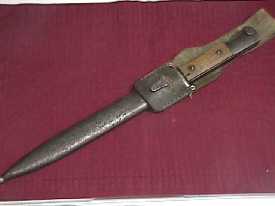
WWII GERMAN 98K BAYONET WITH FROG
The Karabiner 98 Kurz
(often abbreviated Kar98k, K98, or K98k) was a bolt-action rifle adopted as
the standard infantry rifle in 1935 by the German Wehrmacht, and was one of the final developments
in the long line of Mauser military rifles.
The Mauser Karabiner 98k rifle was widely used by all branches of the armed forces of Germany
during World War II. It saw action in every theatre of war involving German forces, including
occupied Europe, North Africa, the Soviet Union, Finland, and Norway.
The 98K bayonet was designed to be mounted on the 98K Mauser rifle. There is a version
of the 98K bayonet that was created
for parade use only. Not meant for combat.
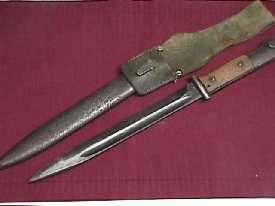
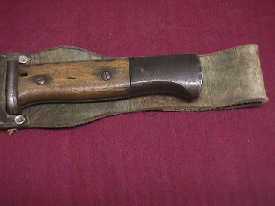
BAYONET DESIGN
The design of the 98K bayonet consisted of bakelite handles (for the early mode bayonets),
wooden handles (as featured on this page) or metal handles for the late war production
bayonets. They were secured to the tang via the use of two rivets. Some models had a smooth
surface while others had a ribbed pattern for a better grip.
The blade is of single edge design. The spine is flat and tapers into a double edge tip.
A blood groove is carved just below the spine. It does not run the full length of the blade.
The blades were dark in color.
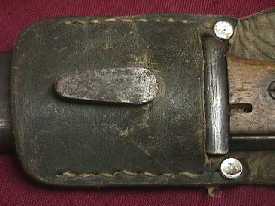
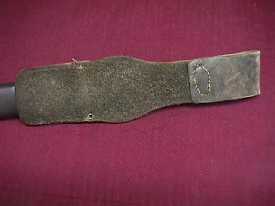
|
The scabbard was made of metal. Of smooth design and complementing the tip with a small
ball. This part could be dented because of its exposure to hard surfaces. The same featured
was carried to the scabbard of daggers.
The front of the scabbard has a heavy duty hook. Its purpose was to provide a support point
from where to attach the frog so that the bayonet could be attached to a belt.
The pommel is of metal construction. Smooth surface. One side has a spring loaded button that
controls the release mechanism. The button must be pressed to take the bayonet off the rifle.
THE FROG
The frog on the bayonet feature here is not the standard issue. However, it is a curious
piece because it seems to fit the bayonet quite well, indicating that it was designed for
this application. Another notable aspect of the frog is that the back is made of swede leather.
The stiching seems to be consistent with the German pattern employed during WWII.
Two rivets are employed to secure the side. An opening is provided for the scabbard hook.
There are no visible markings on this piece.
Notice that the fold-over part does not cover the full length of the scabbard. A circular
pattern stitching is applied to the back.
More than likely this leather frog is a field replacement.
|
|
A sample of an original leather scabbard is shown in the photos below. Of black or brown
color. Heavy duty White cotton stitching secure all pieces. Four rivets, two in the mid section
and two in the upper area are used to enforce the construction.
The upper rivets are applied to form the belt loop. An opening is provided to allow for the
scabbard hook to pass. The back of the frog has a fulllength fold-over section. An additional
stich line runs through the center.
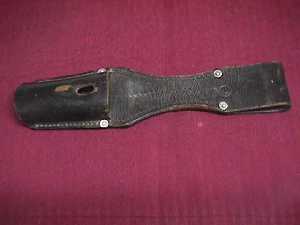
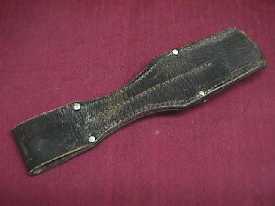
|
This page is a recognition and identification guide for German bayonets. Multiple
detailed photos of a specific sample are provided. Descriptions point out specific
points that should be noted.
One of the most commonly asked questions is "How much is my German bayonet worth?".
A price guide is included here to address this question. The value of the Nazi bayonets is
reviewed over a period of several years. A trend can be observed. The present worth
of the police sword in the collector's market is illustrated.
This service is provided free of charge to the visitor/enthusiast courtesy of
MilitaryItems.com,
a company dedicated
to the preservation of military history and to providing quality military antiques and
collectibles to museums, institutions and the general public.
|
|
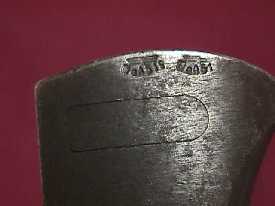
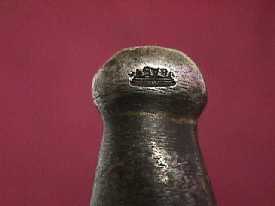
BAYONET MARKINGS
The 98K bayonet has usually has markings in multiple areas. Towards the end of the war the
marking system was not as applied as consistently.
The sample featured here has markings in the pommel area, the tip of the scabbard and the
blade. One of the markings consisted of a series of lines that mimic the shape of the German
eagle. Numbers are placed at the bottom of the claws of the figure.
The bayonet has several markings on the throat section of the blade. One side is marked
"43 asw", where 43 is the year of production 1943 and "asw" is the maker code. The other side
has the serial number 0418, just below that is a cursive marking of "aq".
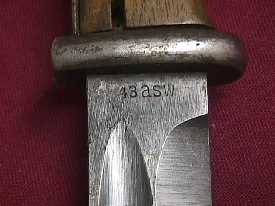
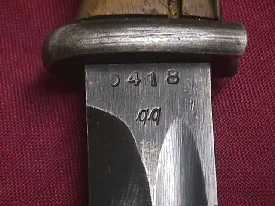
Many German edge weapons are currently reproduced.
It is becoming more difficult to be able to tell the fake ones from the real ones because
the quality of the reproductions is improving. The collector must become familiarized with
the construction style and materials employed in the manufacturing of this item.
Attention to the details is critical in order to be able to determine the authenticity of
the collectible.
If you have an interest is seeing other edge weapons of the Third Reich, you can do so by going
to our WWII German daggers and Swords
identification guide, where we discussed edge weapons from different organizations.
|







